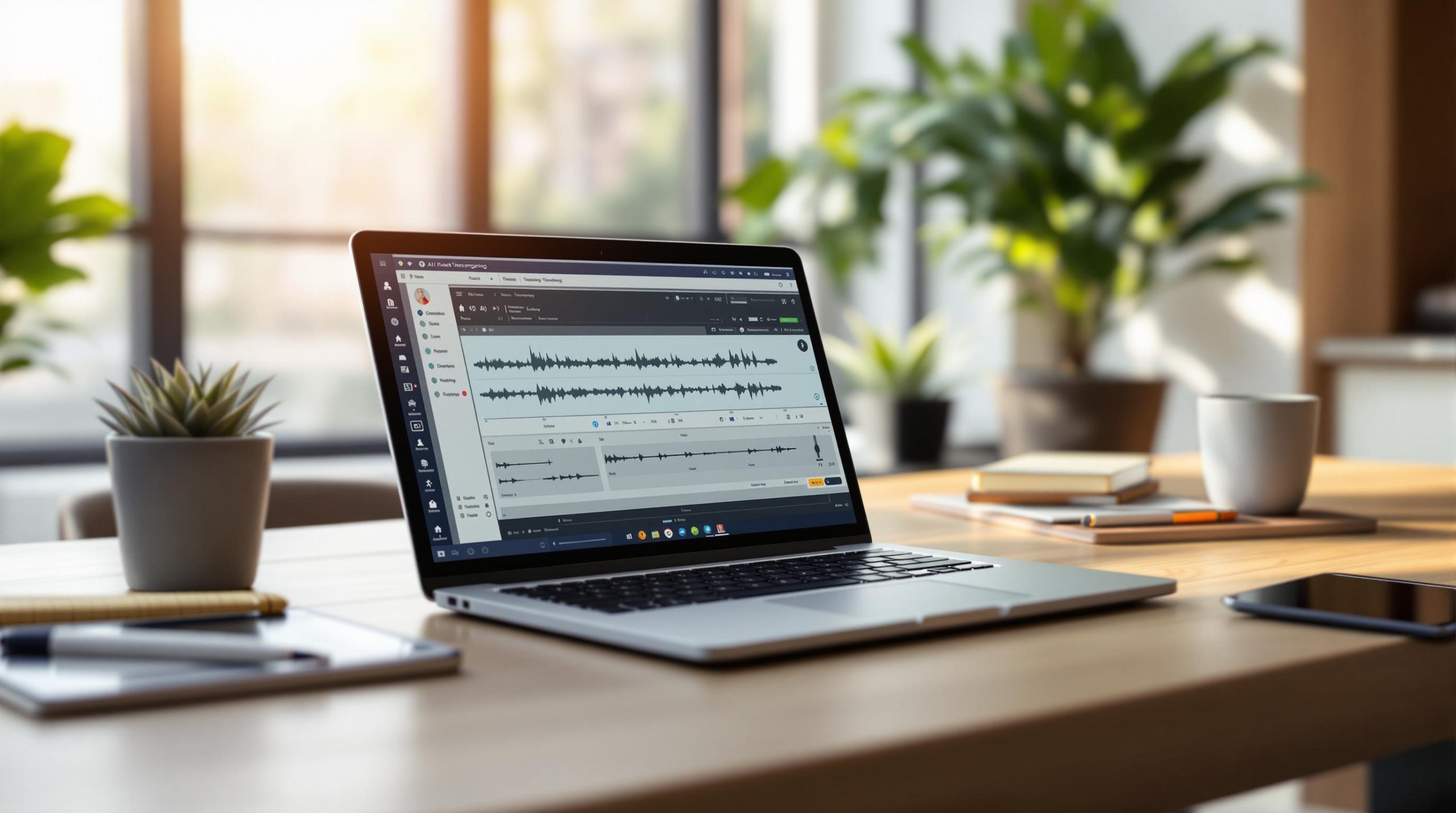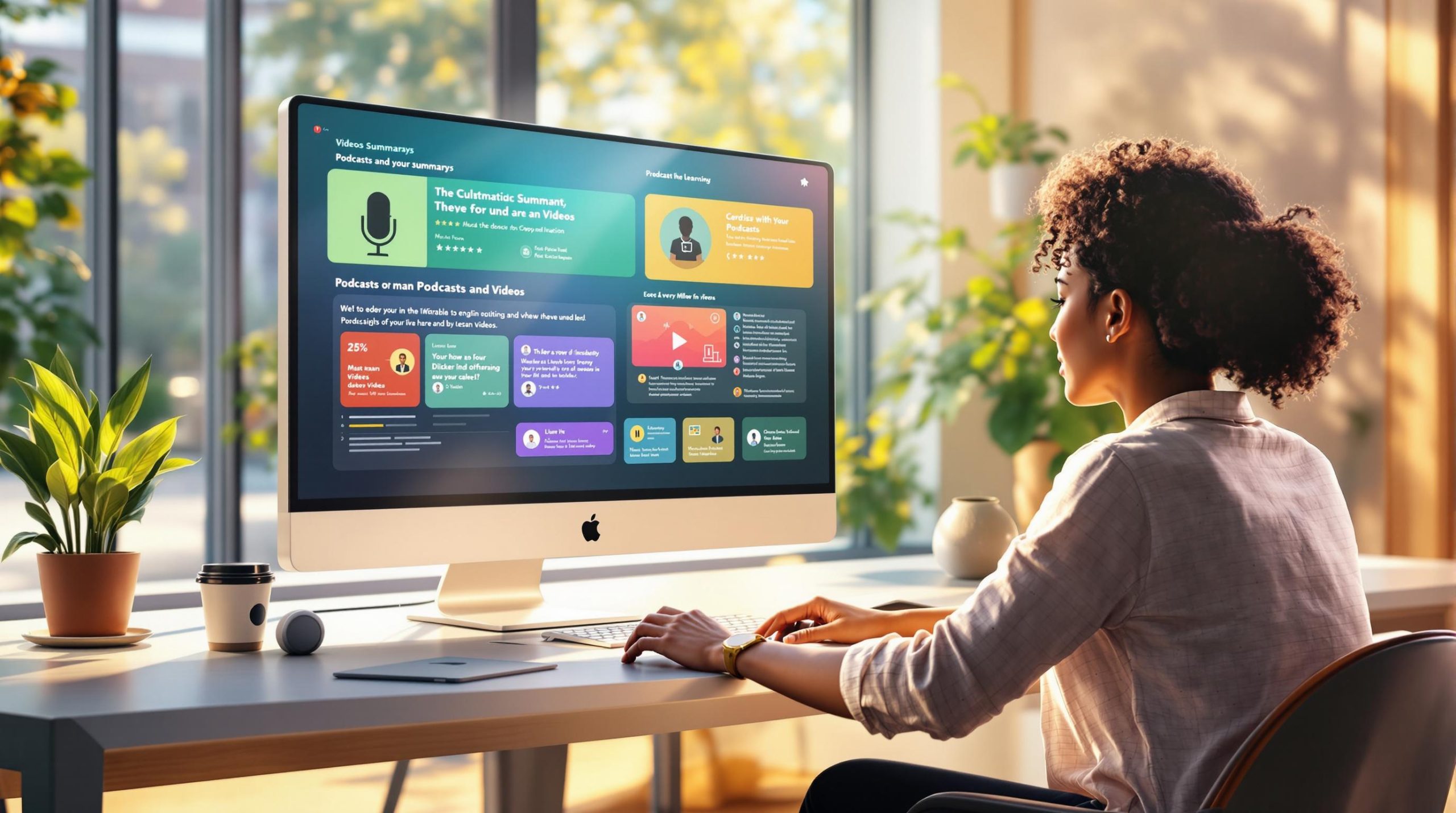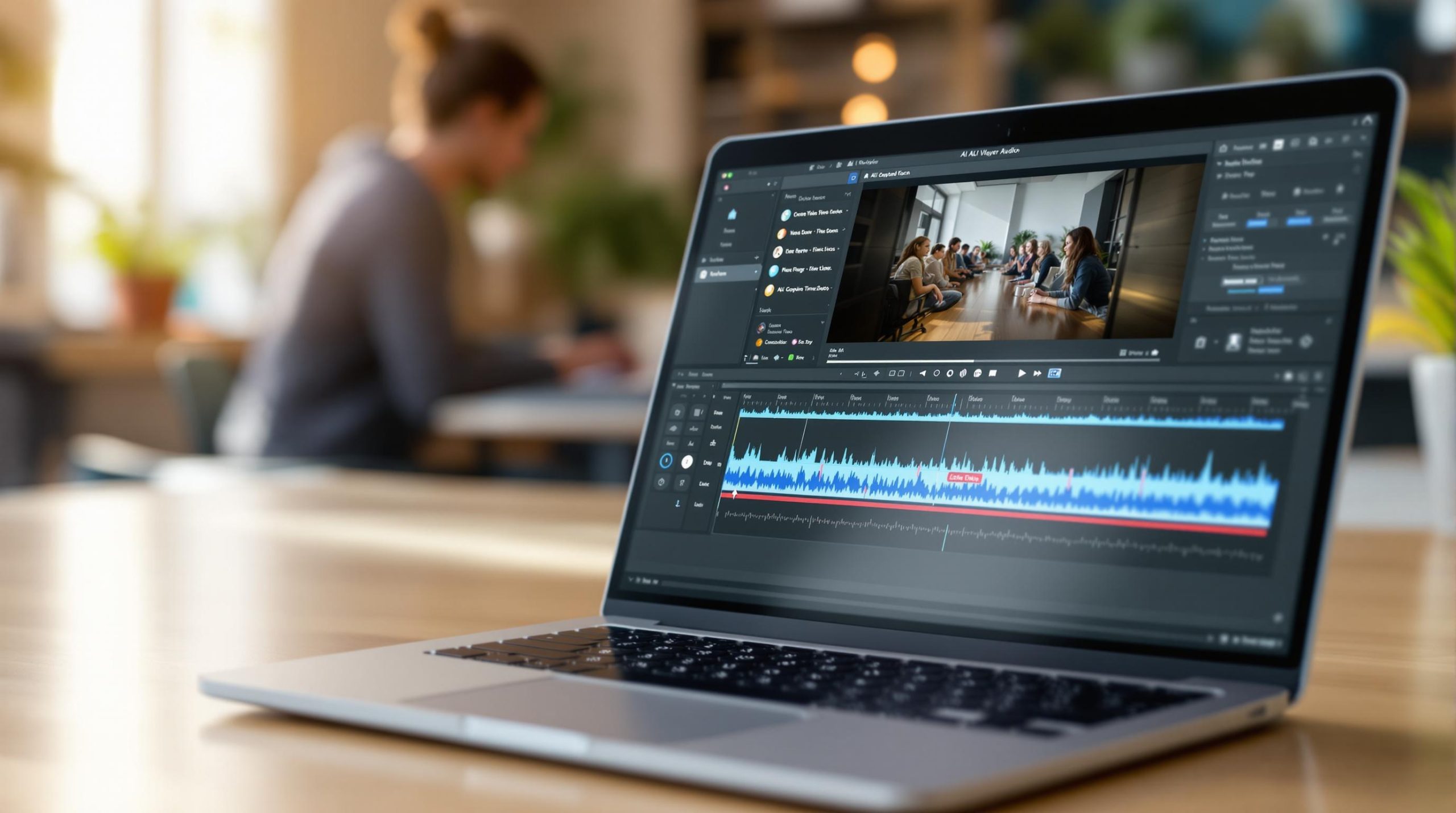Our team tested over 40 AI tools that summarize YouTube videos throughout 2024 to find the quickest time-savers. An hour-long video just needs your full attention, but AI summary tools help you learn the key points in minutes.
Video content’s rapid growth created a clear need for smarter ways to consume information. Tools like ScreenApp and Notta emerged as powerful solutions that support over 104 languages and come with free plans for quick YouTube summaries. ChatGPT’s growing capabilities make many users wonder which option saves more time.
We tested both ChatGPT and dedicated YouTube summarizer tools extensively to help you choose better. This comparison will get into their features, speed, accuracy, and budget-friendly options to find the best fit for your needs.
ChatGPT vs YouTube Summarizers: Understanding the Basics
YouTube video summarization tools compete in different ways. Let’s examine how each technology processes information. ChatGPT and dedicated YouTube summarizers use distinct approaches that impact their speed, accuracy, and user experience.
What is ChatGPT and how it summarizes content
ChatGPT shows excellence in text processing and generation but hits a major roadblock with YouTube videos. Specialized tools outperform it because ChatGPT can’t process audio or video content directly. YouTube videos’ visual and audio elements create a notable challenge.
Users must convert video content into text through transcription before ChatGPT can analyze it. This extra step shows a vital gap in ChatGPT’s multimedia capabilities.
ChatGPT proves its worth in summarization once it has a transcript. The model compresses long text into brief summaries, which helps users who don’t mind the transcription step. GPT-4, GPT-4o, and GPT-4o mini models can handle about 128,000 tokens (50 pages of text) but produce only 4,096 tokens (three pages) at once.
ChatGPT needs well-laid-out prompts to summarize effectively. Users specify their desired length and format to get the best results. Summary quality varies sometimes – important points might be missed or irrelevant details included.
How dedicated YouTube AI summary tools work
Dedicated YouTube summarizer tools handle video content directly, unlike ChatGPT. These AI tools follow three steps:
- They extract the video transcript from YouTube automatically
- The AI analyzes the transcript’s key points and themes
- The analysis generates a brief summary
YouTube summary tools go beyond simple summarization. They generate timestamps, support multiple languages, and let users adjust summary length. Notta AI’s transcription reaches 98.86% accuracy with quality audio.
Top YouTube AI summarizers work with various languages and formats, making them useful for different content types. Browser extensions for Chrome, Firefox, and others let users summarize videos with one click while watching YouTube.
Key differences in technology and approach
These technologies differ in their core purpose. ChatGPT serves as a general-purpose text processor, while YouTube summarizers focus on video content. This specialization gives YouTube summarizers unique features.
Technology differences include:
- Direct integration: YouTube summarizers link to the video platform without manual steps
- Visual context: Advanced YouTube summarizers include video elements beyond transcripts
- Time-based navigation: Summaries link to specific video sections through timestamps, a feature ChatGPT lacks
YouTube summarizers process videos of any length in real-time, from quick clips to lengthy lectures. Advanced features like speaker identification and automatic corrections ensure accurate transcriptions.
ChatGPT users switch between platforms and handle transcription themselves, creating extra work compared to dedicated tools’ smooth experience. ChatGPT’s strong language processing still makes it useful for users with transcripts or those who need versatile summarization options.
Feature Comparison: What Each Option Offers
Tools that summarize YouTube videos can really change how you work. ChatGPT and YouTube summarizers each bring their own set of features to match what different users need.
ChatGPT’s summarization capabilities
ChatGPT goes beyond simple content condensation. The Summarizer API lets users create summaries in different lengths and formats – from sentences to paragraphs and bullet points. Users can tailor these summaries to what they need.
ChatGPT shines in handling different types of content. It works with YouTube transcripts, text, code, scripts, musical pieces, emails, and letters. You can pick the summary type (key-points, tl;dr, teaser, headline), format (markdown or plain-text), and length (short, medium, long).
The models can handle about 128,000 tokens – equal to 50 pages of text. This works well for most news articles and regular videos. Longer research papers might need splitting because of the 4,096 token limit per response.
Common features of YouTube video summary tools
YouTube summarizers come with features built just for video content. Most tools keep it simple: copy the video link, create the summary, and read what the AI produces. Users who want quick results love this approach.
These tools let you format summaries your way. NoteGPT adjusts summary length to what you need. Many platforms give you both bullet-points and paragraphs to match how you like to read.
Language support makes these tools stand out. Many summarizers work with over 40 languages, helping users worldwide. Researchers and professionals who watch content in different languages find this really helpful.
The tools also add timestamps that connect summaries to specific video parts. ChatGPT doesn’t have this feature, but it helps users find key moments in long videos quickly.
Integration with other platforms
How these tools connect with other services sets them apart. YouTube summarizers often come with browser extensions that merge naturally with YouTube. Users don’t need to jump between different platforms.
ChatGPT doesn’t connect directly to YouTube but offers more ways to integrate through its API. Developers can add its summary features to various apps and workflows. Companies often use it with their project tools and document storage.
YouTube summarizers let users share summaries straight to social media and other platforms. Tools like IFTTT’s AI Summarizer connect to Email, Google Docs, Telegram, Twitter, and Discord.
These connections make both options more than just summary tools. They become key parts of bigger productivity systems.
Speed Test: Which Option Delivers Faster Results
Speed plays a crucial role in picking AI tools that turn hours of video content into quick reads. Our tests show that these solutions’ delivery speed varies substantially based on multiple factors.
Processing time for different video lengths
YouTube summarizers beat ChatGPT in most scenarios when it comes to video processing speed. Tools like Eightify create summaries “in one click” and users don’t need to switch tabs or type prompts manually. This direct integration creates efficient workflows that save time.
Short videos under 10 minutes get almost instant results from specialized YouTube summarizers. Knowt’s AI video summarizer needs less than 30 seconds to process content, which makes it perfect for quick information extraction. Tools like ScreenApp process content live and give instant summaries while keeping the context intact.
The processing gap between these options grows with video length. Here’s what happens with longer educational content or lectures:
- YouTube summarizers: Most finish summaries within 2-4 minutes whatever the video length
- ChatGPT: Needs manual transcription first, then processing time, often taking 5+ minutes or more
This gap becomes even more obvious with videos longer than 30 minutes. Dedicated tools keep their performance steady while ChatGPT’s multi-step process creates more delays.
Real-time vs. batch processing capabilities
The biggest difference between these options lies in how they process content. YouTube summarizers use live processing. They analyze data as it comes in and show results right away. Live systems want minimal delay, often just milliseconds, which works great when you need instant insights.
ChatGPT uses batch processing instead. It collects data over time and processes everything at once. This method manages resources well but leads to longer delays that can last minutes or hours.
These technical differences create unique user experiences:
- Input handling: YouTube summarizers pull video transcripts automatically, but ChatGPT needs manual transcript input
- Processing speed: Live YouTube tools give “blazingly fast summaries” and analyze even long videos in seconds
- Resource utilization: Live processing uses more computing power, which explains why some YouTube summarizers’ premium tiers offer faster processing
Users who want quick insights will find YouTube summarizers more helpful. FastPix’s Video AI lets users get key insights “in seconds instead of hours”. ChatGPT works better for batch tasks where time isn’t critical, like summarizing multiple videos for research.
Your specific time limits and workflow needs should guide your choice between these options. Dedicated YouTube summarizers deliver faster results through their specialized live processing features when you need immediate output.
Accuracy Analysis: Quality of AI-Generated Summaries
The quality of summary content makes the difference between great and average AI tools. Our tests show ChatGPT and dedicated YouTube summarizers handle video content summaries quite differently.
Content comprehension and context retention
AI summary tools vary in quality, but YouTube-specific summarizers are better at keeping context intact. Research shows AI summaries work well with simple content but have trouble with complex topics. These tools sometimes miss important context or mix up the sequence of information.
Tests across YouTube, EPFL, and TVSum datasets show advanced deep learning summarization tools achieved great results: 79.2% precision, 86.5% recall, and an 83% F-score. These numbers prove that specialized video summarization tech can be highly accurate with proper implementation.
Research comparing AI and human-written science summaries revealed something interesting. Readers understood complex information better from AI summaries. They remembered more details and gave more accurate descriptions than those who read human-written versions.
Handling technical jargon and specialized content
The difference between these tools becomes clearer with specialized content. Tools like Scholarcy and Resoomer are built specifically to handle academic papers and complex reports. ChatGPT often misinterprets data or misses important citations.
Technical content creates specific challenges:
- Speech quality effect: Bad audio, noise, and accents affect how well the tool recognizes speech and creates summaries
- Visual elements: Better video summarizers look at both visuals and transcripts to understand more
- Context preservation: Special tools keep technical terms accurate
Special summarizers work better with research papers and technical videos. They pull out key findings, citations, and organize complex information effectively. This makes them essential for professionals and academics who need precise technical details.
Accuracy with different video formats and styles
Different video types and styles affect accuracy. New tech like CNNs, LSTM networks, and ResNet50 has made video summaries much better than older methods.
Educational videos are easier for both tools because they have clear speech and good structure. Videos with multiple speakers, overlapping voices, or background noise create bigger challenges, especially for tools that rely on transcription.
ChatGPT works best with pre-transcribed content but struggles with direct video processing. YouTube summarizers use speech recognition, natural language processing, and computer vision to analyze both sound and picture.
This multi-media approach helps YouTube summarizers do better with content where visuals matter. The best AI tools still miss jokes, subtle meanings, or specific technical terms sometimes. Summary quality depends on clear video, good speech recognition, and the language model’s capabilities.
Cost Comparison: Free vs. Premium Options
AI video summarization tools have different price points that affect their accessibility and value. ChatGPT and YouTube summarizers let you start for free. Their paid versions cater to different user needs and budgets.
ChatGPT pricing tiers and limitations
ChatGPT’s pricing model lets you choose from several options based on what you want and how much you use it:
- Free Plan: You get simple access to GPT-4o mini and some access to GPT-4o and o3-mini. You can upload files and create images, but daily limits apply when many people use it.
- Plus Plan: This $20/month option gives you more room to message, upload files, analyze data, and generate images. You also get standard and advanced voice features with video and screen sharing.
- Pro Plan: The $200/month premium option lets you use all reasoning models, GPT-4o, and advanced voice features without limits. You’ll also get more time with Sora video generation and priority access during busy times.
The free plan works well enough to summarize YouTube videos, but it runs into limits often. Plus users can send 80 messages to GPT-4o every three hours, which helps when you process several videos.
YouTube summarizer pricing models
YouTube summarizers cost less than ChatGPT’s premium versions:
- Free Tier Prevalence: Most tools give you a free plan with simple features. NoteGPT shows subtitles free and charges a small fee to get AI summaries. Recall Lite gives you 10 AI summaries at no cost.
- Monthly Subscription Range: Premium plans cost between $4.99 and $14.99 monthly. ChatGPT for YouTube asks for $4.99/month. Eightify costs $5.99/month yearly or $8.99/month. YouTube Summarizer with ChatGPT charges $6.99/month.
- Annual Discounts: You save money with yearly plans. Summari gives you a $20 discount for paying annually – $99/year instead of $9.99/month.
Some tools use credits instead of unlimited access. You pay only for summaries you want rather than getting a subscription.
Value for money assessment
The best value depends on several things:
Usage Frequency: Free plans or credit systems work better if you summarize videos occasionally. Unlimited subscriptions make more sense when you process many videos daily.
Time-Value Equation: Premium plans save time. ChatGPT Plus users ($20/month) can save 5-10 hours each month, worth about $500-$1,000 in work time.
Feature Requirements:
- Simple summaries: Free YouTube summarizers work well enough
- Customization: Mid-tier options ($5-$15/month) give you the best balance
- Enterprise needs: Higher-tier plans with API access and team features make sense despite higher costs
Content Complexity: YouTube summarizers work great for standard videos. ChatGPT’s advanced models (especially Pro tier) handle technical content better.
Most YouTube summarizers let you make unlimited summaries with premium plans, unlike ChatGPT’s message limits. YouTube Summarized Plus gives you unlimited summaries in any language, which helps if you use it often.
The right choice comes down to how you use these tools. Casual users get more value from free or low-cost YouTube summarizers. Power users who want advanced features or process lots of videos might find ChatGPT Plus worth the higher price.
Technical Requirements and Limitations
The usability and accessibility of a YouTube summarizer depends on its technical requirements. You need to understand these technical aspects to find an AI solution that works with your setup and workflow.
Device compatibility and system requirements
Different summarizers work with different browsers. Most tools support Chrome, Safari, Edge, Brave, and Opera. You’ll find dedicated extensions that work smoothly with your preferred browser. YouTube Summary with ChatGPT & Claude works as a Chrome Extension that runs on multiple platforms.
YouTube summarizers usually work on various platforms:
- Desktop support: Works on both Windows and Mac operating systems
- Mobile compatibility: Many have Android and iOS apps
- Web-based access: Works in browsers on any device
ChatGPT runs through its web interface and works with modern browsers but doesn’t connect directly to YouTube. Users have to switch between platforms, which makes the experience less efficient.
API access and developer options
Developers who want to add summarization features to their apps have several ways to integrate. API access needs authentication through API keys, which you can get from the service provider’s developer portal.
ChatGPT has powerful API options to build custom summarization tools. Some developer-friendly AI tools need you to provide your own API keys, so you’ll pay based on the tokens you use.
API availability changes between YouTube summarizer providers. Some give developer access in their premium plans, while others keep their systems closed. The integration usually needs HTTP requests to API endpoints with API keys and the right headers and parameters.
Video length and format restrictions
Video length limits matter when you pick summarization tools. Most YouTube summarizers don’t put strict limits on video length, and some clearly state they have “no restrictions”. Many platforms can handle videos of any length and still give quality results.
These tools mainly work with standard YouTube videos, but some can handle content from Facebook, Instagram, and direct video uploads. They do have some limits on file types and content:
- They can’t process fully scanned PDFs
- Digital images with text don’t work
- Tables in scanned documents might not show up right
Processing limits vary too. Some services won’t take files bigger than 10 MB or limit batch processing to 20 documents.
Comparison Table
| Feature | ChatGPT | YouTube Summarizers |
|---|---|---|
| Processing Capability | Processes ~128,000 tokens (50 pages), outputs max 4,096 tokens | Handles videos regardless of length without specific token limits |
| Direct Video Processing | Cannot handle video/audio directly and needs manual transcript | Processes videos directly with automatic transcript generation |
| Processing Speed | Takes 5+ minutes including manual transcription | Processes long videos in 2-4 minutes; short videos under 30 seconds |
| Language Support | No specific mention | Supports 40+ languages with some tools offering 104 languages |
| Basic Pricing | Free: Simple access Plus: $20/month Pro: $200/month |
Simple plans at no cost Premium: $4.99-$14.99/month |
| Key Features | – Multiple summary formats – Adjustable length – Support for various content types – Different output options |
– Timestamp creation – Immediate processing – Browser add-ons – YouTube integration |
| Accuracy | Performs well with transcribed content but might miss context | Delivers up to 98.86% transcription accuracy with better context understanding |
| Integration Options | Developer API available but needs platform switching | Offers browser extensions, YouTube integration, and multi-platform support |
| Technical Requirements | Needs web browser access | Works on Desktop, Mobile, and Browser platforms |
| Visual Context | Cannot process visual elements | Includes video visual elements in analysis |
Conclusion
Testing shows that YouTube summarizers beat ChatGPT at analyzing video content. These tools process videos by a lot faster – just 2-4 minutes compared to ChatGPT’s 5+ minutes. They also achieve better accuracy rates of up to 98.86%.
YouTube summarizers shine with their direct platform integration, live processing, and support for 104 languages. ChatGPT handles text content well, but needs manual transcription that slows down the workflow.
The cost makes YouTube summarizers a better deal for most people. ChatGPT’s Plus plan costs $20 per month, while specialized summarizer tools cost between $4.99 and $14.99 monthly. Free plans from dedicated summarizers are enough to meet basic needs, especially when you have casual users.
YouTube summarizers ended up as the best choice to process video content quickly. ChatGPT still works great for users who need advanced text analysis or already have transcribed content. Power users might want both tools – YouTube summarizers for quick video processing and ChatGPT to analyze important transcripts in depth.














